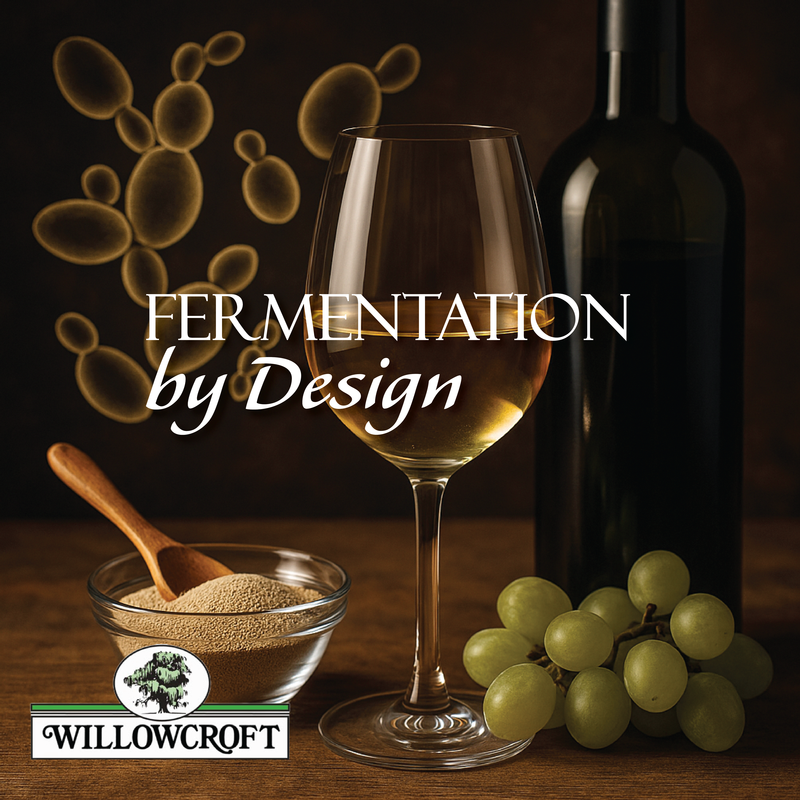Fermentation by Design: How Yeast Creates Style, Texture, and Taste

In our previous blog (Native Yeast vs. Cultured Yeast, posted August 5), we explored how winemakers choose between wild and commercial yeast to begin fermentation. But once that decision is made, the real work begins. Yeast doesn’t just start fermentation—it has an ongoing and powerful influence on how a wine tastes, feels, and evolves.
In Part 2 of our yeast series, we examine what happens after yeast is introduced and how its role influences the final product. From citrusy aromatics to creamy textures and decisions about sweetness, yeast is one of the most essential style tools in a winemaker’s hands.
The primary role of yeast is to convert the sugars in grape juice into alcohol and carbon dioxide. But along the way, yeast produces hundreds of aromatic and textural compounds. These include esters, alcohols, and amino acids that contribute to the wine’s overall flavor and mouthfeel.
The aromas we associate with different styles of wine—like citrus in a white or stone fruit in a rosé—can often be linked to the specific yeast strain used and the fermentation conditions selected. Many of these flavor notes are not found in the grapes themselves but are byproducts of fermentation.
Cultured yeasts are developed to offer specific benefits, such as promoting clean fermentation, enhancing certain aromas, or improving texture. Winemakers can select strains that support their vision for the wine, whether that’s preserving crisp acidity, deepening the mouthfeel, or ensuring a slow, even fermentation.
At Willowcroft, we thoughtfully select yeast strains based on the varietal, the vintage, and the desired outcome. Using cultured yeast enables us to consistently support clean, healthy fermentations and accurately express the style of each wine. For example, we may select strains that enhance floral or citrus notes in white wines or those that develop more structure and a smooth texture in reds. Our choices are strategic and driven by experience, with an emphasis on preserving balance, character, and purity in the final product.
Temperature is a key factor in how yeast behaves. Cooler fermentations tend to slow yeast activity and preserve more delicate aromatics, especially in white and rosé wines. This is how you get those fresh citrus or melon notes. Warmer fermentations, more typical for reds, encourage greater extraction of tannin and color and can emphasize deeper, more robust flavors.
By controlling fermentation temperature in conjunction with yeast selection, winemakers can shape the overall tone of the wine—from bright and fruit-forward to rich and layered.
Sometimes, fermentation is intentionally stopped before the yeast has converted all of the sugar into alcohol. This results in a wine with residual sugar and a naturally off-dry or semi-sweet profile. In cool-climate wines with high acidity, that small amount of sugar can create balance and lift. In others, it helps highlight specific fruit characteristics.
Stopping fermentation requires precision. The wine may be chilled to slow yeast activity, filtered to remove yeast cells, or treated with sulfur to inhibit further fermentation. These decisions must be made carefully and are often best executed when using cultured yeast, which offers predictability and cleaner outcomes.
At Willowcroft, this approach is used selectively to craft wines that remain vibrant and well-balanced, especially in varietals like Vidal Blanc or Traminette, where a touch of natural sweetness can elevate aromatics and round out the palate.
After fermentation, yeast cells settle in the wine and form what’s called the lees. In some wines, particularly white wines and sparkling wines, aging the wine on its lees can enhance richness and complexity. As the yeast cells break down, they release compounds that contribute a creamy or silky texture and subtle notes, such as those of fresh bread or nuttiness. This process—called autolysis—is a hallmark of traditional-method sparkling wine, but also plays a role in shaping the mouthfeel of certain still wines.
Lees contact is another example of how yeast contributes to the wine long after fermentation is complete, adding both weight and finesse to the wine.
Yeast is often referred to as the "invisible ingredient" in wine, but its impact is anything but subtle. Through careful strain selection, temperature control, and fermentation management, winemakers guide the development of aroma, structure, and balance.
At Willowcroft, our approach to yeast is thoughtful and deliberate. Every choice is made to support the fruit, the vintage, and the expression of the vineyard itself. Whether we’re working with a bright Albariño or a structured Petit Verdot, our yeast decisions help carry each wine from grape to glass with clarity and integrity.
Fermentation is far more than a chemical reaction—it’s a design process. Yeast doesn’t just make wine; it shapes it. From flavor to finish, yeast is one of the most potent tools in winemaking, allowing the character of the vineyard to take form in the bottle.
When you enjoy a glass of Willowcroft wine, you’re tasting more than fruit. You’re tasting the result of carefully considered choices made during fermentation—choices that preserve freshness, amplify expression, and deliver a wine with style and purpose.

